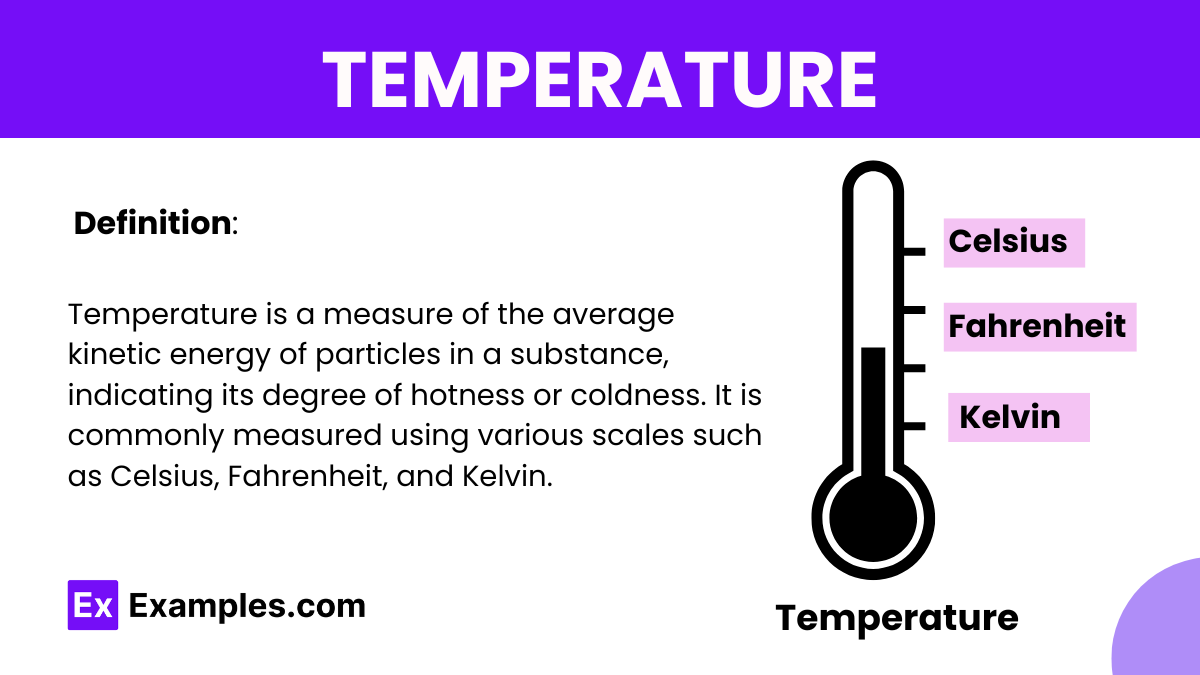What is the SI unit of temperature?
Fahrenheit
Celsius
Kelvin
Rankine

Temperature is a fundamental concept in physics that measures the degree of hotness or coldness of a substance or object. It plays a crucial role in various phenomena, including conduction, a mode of heat transfer characterized by the transfer of energy through direct contact between materials, and radiation, the emission or absorption of energy in the form of electromagnetic waves. Understanding temperature is essential for comprehending the behavior of matter and energy in diverse systems and processes.
One of the best examples of temperature is the measurement of body temperature in humans. Body temperature is crucial for maintaining physiological functions and is typically measured using a thermometer. Normal body temperature varies slightly from person to person but is generally around 37 degrees Celsius (98.6 degrees Fahrenheit). Deviations from this range can indicate health conditions such as fever (elevated temperature) or hypothermia (low temperature). Monitoring body temperature is essential in medical settings for diagnosing illnesses and assessing overall health.
where F is the temperature in Fahrenheit and C is the temperature in Celsius.
Example: Convert 20°C to Fahrenheit.
where C is the temperature in Celsius and F is the temperature in Fahrenheit.
Example: Convert 68°F to Celsius.
where K is the temperature in Kelvin and C is the temperature in Celsius.
Example: Convert 20°C to Kelvin.
K = 20+273.15 = 293.15K

Temperature and kinetic energy are closely related concepts in physics, particularly in the study of thermodynamics. The relationship between temperature and kinetic energy can be understood through the kinetic theory of gases, which describes how the motion of particles (atoms or molecules) in a substance contributes to its temperature.
Kinetic Theory of Gases:
Mathematical Relationship:
Implications:
Experimental Confirmation:
Experimental observations support the relationship between temperature and kinetic energy. For example, heating a gas in a closed container causes an increase in pressure due to the greater kinetic energy of the gas particles.
| Heat | Temperature |
|---|---|
| Heat is a form of energy transfer | Temperature is a measure of hotness or |
| that flows from a hotter object | coldness of an object or substance |
| to a colder object | heat is exchanged between a hot and cold object |
| Joules (J) or calories (cal) | Degrees Celsius (°C), Fahrenheit (°F) |
| Q | T |
| Heat is measured in terms of the | Temperature is measured using |
| amount of energy transferred | thermometers |
| Heating water on a stove | A thermometer reading |
| Melting ice into water | Ice melting into water at 0°C |
| Boiling water to produce steam | Water at 100°C boiling into steam |
Temperature measurement refers to the process of quantifying the degree of hotness or coldness of an object or substance. Several methods are used to measure temperature, each relying on different physical principles and technologies. Here’s an explanation of temperature measurement methods:
Temperature has a profound impact on various aspects of the natural world and human activities. Some of the effects of temperature include:
The Kelvin scale is considered an absolute temperature scale because its zero point, absolute zero, is the theoretical lowest temperature at which all molecular motion ceases.
Temperature measurement is used in various fields, including weather forecasting, cooking, industrial processes, healthcare, and scientific research. It is essential for controlling processes, monitoring environmental conditions, and ensuring safety in many applications.
In space, scientists use instruments such as infrared telescopes and radiometers to detect thermal radiation emitted by celestial objects.
Text prompt
Add Tone
10 Examples of Public speaking
20 Examples of Gas lighting
What is the SI unit of temperature?
Fahrenheit
Celsius
Kelvin
Rankine
At what temperature does water boil at standard atmospheric pressure?
100°C
212°F
373 K
0°C
What is the freezing point of water in Kelvin?
273 K
0 K
32 K
100 K
Which temperature scale is based on absolute zero?
Celsius
Kelvin
Fahrenheit
Rankine
What is the relationship between Celsius and Fahrenheit at absolute zero?
Both are zero
Celsius is zero and Fahrenheit is 32
Celsius is -273 and Fahrenheit is -459
Both are -273
What does a temperature difference of 1 Kelvin represent in Celsius?
1°C
2°C
0.5°C
0.1°C
At what temperature do the Celsius and Fahrenheit scales read the same value?
100
0
-40
32
What is the boiling point of water in Fahrenheit?
32°F
100°F
212°F
273°F
Which temperature scale has a zero point that represents the freezing point of water?
Celsius
Fahrenheit
Kelvin
Rankine
What is the equivalent of 0 Kelvin in Celsius?
0°C
-273°C
273°C
-100°C
Before you leave, take our quick quiz to enhance your learning!

